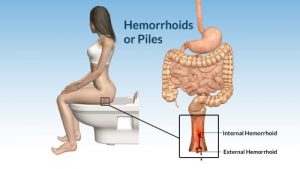Hemorrhoids or piles are a condition characterized by occurrence of swollen blood vessels in and around anus. These are of two types: internal and external hemorrhoids.
Internal hemorrhoids are those which lie inside the rectum, far enough from the anus that one cannot see or feel them.

Causes of Internal Hemorrhoids
Internal hemorrhoids have the same causes as those of external hemorrhoids. Although the exact cause for hemorrhoids is still unknown but hemorrhoids may be caused due to varicose veins which may be inherited or weakness in the veins present in the rectum and anus. Extreme abdominal pressure may lead to swelling up of veins that become susceptible to irritation. Sitting or standing for long durations, obesity, straining on the toilet, pregnancy, sneezing, coughing, vomiting and holding the breath for long time, are some of the factors that may exert pressure on these veins.
Piles are also related with diet. Eating more fibrous diet helps in preventing hemorrhoids while eating processed foods may increase the risk of developing hemorrhoids. Constipation causing factors like inadequate liquid intake or low fibre diet may also irritate the swollen veins, aggravating piles.
Signs and symptoms of Internal Hemorrhoids
These are mostly painless due to presence of lesser number of sensory nerves inside the rectum. But one may be able to see or feel them as pinks and moist pads of skin when these grow abruptly and enlarge to protrude outside the anal sphincter. This is also characterized by inflammation or redness around the protruding hemorrhoids.This happens in case of prolapsed hemorrhoids which are painful due to presence of more sensory nerves in anus. Internal hemorrhoids can be classified into 4 grades depending upon the extent of protrusion as:
Grade 1 – when there is no prolapse
Grade 2 – when these hemorrhoids protrude only at the time of passing bowel and come back inside after some time.
Grade 3 – these protrude at the time of bowel movement but need to be pushed back manually
Grade 4 – these are the most severe kind of internal hemorrhoids and cannot be pushed back manually.
Bleeding is the most common feature of this type of hemorrhoids which helps to recognise its existence when pain is absent. One may see bright red streaks of blood along with bowel or on toilet paper especially while passing out stools. Sometimes the bleeding can be chronic and profuse with more than just streaking.
Sometimes, there is discomfort and pain during the bowel movement due to rubbing of the walls of hemorrhoids by the bowel.
Diagnosis of Internal Hemorrhoids
Internal hemorrhoids can be diagnosed by careful clinical examination by the doctor where the doctor examines the anus either with gloved and lubricated finger or through anoscope or a protoscope that are inserted inside the rectum. Other ways may be through colonoscopy or sigmoidoscopy which include insertion of a flexible tune for viewing the deeper parts of rectum or colon. Barium enema followed by X-ray of lower gastro-intestinal tract may also be helpful.
It is necessary to rule out other diseases associated with anal bleeding. These include Crohn’s disease, anal fissure, colitis and colorectal cancer.
Treatment of Internal Hemorrhoids
- Diet modifications: One must take sufficient fibre in diet as well as plenty amount of water to prevent constipation to relieve discomfort. Although there is no permanent cure for this but one must take necessary measures to lower the discomfort.
If the symptoms don’t subside, other measures may be taken by the doctor:
- Sclerotherapy or injection with a scar forming solution to close the hemorrhoid. It is used as an alternative to banding.
- Rubber band litigation in case of prolapsed hemorrhoids. This is done to lower down or remove the blood supply to the hemorrhoids.
- Cauterization and coagulation using laser beam or electric probe or infrared light.
- Surgery for the removal of grade three or grade four internal hemorrhoids.

